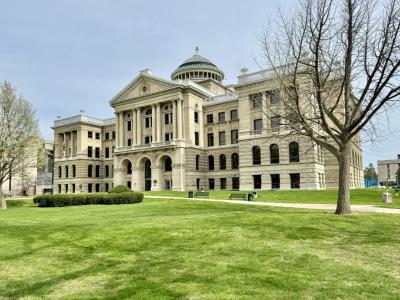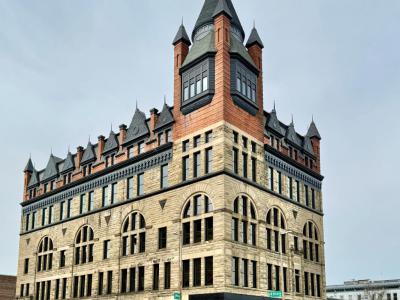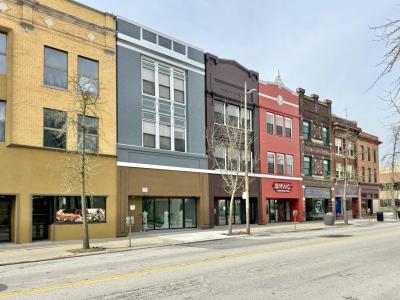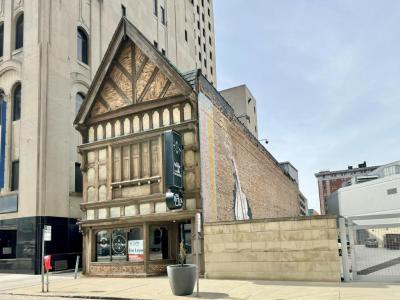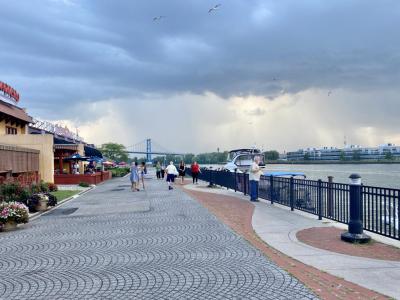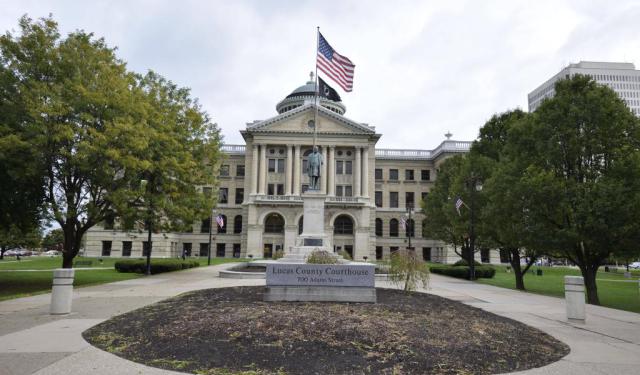
Toledo Downtown Walking Tour (Self Guided), Toledo
For decades, Toledo, Ohio, was merely a waypoint for travelers en route to or from Michigan. Located at the western tip of Lake Erie along the Maumee River (a key part of the city's today's allure and social life), Toledo was founded in 1833. The area’s transition from a frontier society to a busy urban center was significantly bolstered by the Miami and Erie Canal in 1845 and its strategic position on a major railway line between New York City and Chicago.
Many believe that Toledo, Ohio, owes its name to the Spanish city of Toledo, though its true origin remains unclear and shrouded in legends. Some attribute it to Washington Irving, an American writer, who traveled in Spain at the time and suggested naming it after the Iberian counterpart. Others credit a local merchant, who favored the word “Toledo” for its uniqueness (in America) and phonetic appeal.
Initially a bustling commerce hub – due to the convergence of railways, waterways, and industries such as glass manufacturing, – it attracted a diverse immigrant population. The first of many glass makers arrived here in the 1880s, eventually earning Toledo its nickname "The Glass City". Another popular moniker, "Holy Toledo", is thought to be originally a reference to the city's array of grand church designs: Gothic, Renaissance, and Spanish Mission.
Despite the economic downturns of the Great Depression in the 1930s, Toledo's growth continued, with the post-WWII era seeing a rise in its African American population due to the Great Migration, leading to community enrichment. More recently, downtown Toledo has seen a revival, becoming a lively entertainment district.
Among its architectural gems is the Lucas County Courthouse, an imposing structure reflecting the Beaux-Arts style, which has presided over the city's legal affairs since the late 19th century. Not far from the murmur of courthouse deliberations, the Old Central Post Office, with its robust Romanesque Revival façade, whispers tales of letters and parcels that once connected Toledoans to the wider world. The Young Men’s Christian Association Building and Pythian Castle echo similar stories of communal bonds and fraternal orders that shaped the city's social fabric.
Toledo’s transformation and embrace of the future are perhaps best symbolized by its revitalized Riverfront and Promenade Park.
The city’s architectural and historical landmarks are not merely relics but are vibrant chapters of a continuing story. To those with a keen eye, Toledo beckons with open arms. So, come and discover the beauty, the history, and the spirit of this charming city on this self-guided tour!
Many believe that Toledo, Ohio, owes its name to the Spanish city of Toledo, though its true origin remains unclear and shrouded in legends. Some attribute it to Washington Irving, an American writer, who traveled in Spain at the time and suggested naming it after the Iberian counterpart. Others credit a local merchant, who favored the word “Toledo” for its uniqueness (in America) and phonetic appeal.
Initially a bustling commerce hub – due to the convergence of railways, waterways, and industries such as glass manufacturing, – it attracted a diverse immigrant population. The first of many glass makers arrived here in the 1880s, eventually earning Toledo its nickname "The Glass City". Another popular moniker, "Holy Toledo", is thought to be originally a reference to the city's array of grand church designs: Gothic, Renaissance, and Spanish Mission.
Despite the economic downturns of the Great Depression in the 1930s, Toledo's growth continued, with the post-WWII era seeing a rise in its African American population due to the Great Migration, leading to community enrichment. More recently, downtown Toledo has seen a revival, becoming a lively entertainment district.
Among its architectural gems is the Lucas County Courthouse, an imposing structure reflecting the Beaux-Arts style, which has presided over the city's legal affairs since the late 19th century. Not far from the murmur of courthouse deliberations, the Old Central Post Office, with its robust Romanesque Revival façade, whispers tales of letters and parcels that once connected Toledoans to the wider world. The Young Men’s Christian Association Building and Pythian Castle echo similar stories of communal bonds and fraternal orders that shaped the city's social fabric.
Toledo’s transformation and embrace of the future are perhaps best symbolized by its revitalized Riverfront and Promenade Park.
The city’s architectural and historical landmarks are not merely relics but are vibrant chapters of a continuing story. To those with a keen eye, Toledo beckons with open arms. So, come and discover the beauty, the history, and the spirit of this charming city on this self-guided tour!
How it works: Download the app "GPSmyCity: Walks in 1K+ Cities" from Apple App Store or Google Play Store to your mobile phone or tablet. The app turns your mobile device into a personal tour guide and its built-in GPS navigation functions guide you from one tour stop to next. The app works offline, so no data plan is needed when traveling abroad.
Toledo Downtown Walking Tour Map
Guide Name: Toledo Downtown Walking Tour
Guide Location: USA » Toledo (See other walking tours in Toledo)
Guide Type: Self-guided Walking Tour (Sightseeing)
# of Attractions: 10
Tour Duration: 2 Hour(s)
Travel Distance: 2.4 Km or 1.5 Miles
Author: AliceM
Sight(s) Featured in This Guide:
Guide Location: USA » Toledo (See other walking tours in Toledo)
Guide Type: Self-guided Walking Tour (Sightseeing)
# of Attractions: 10
Tour Duration: 2 Hour(s)
Travel Distance: 2.4 Km or 1.5 Miles
Author: AliceM
Sight(s) Featured in This Guide:
- Lucas County Courthouse
- St. Paul’s Evangelical Lutheran Church
- Old Central Post Office
- Young Men’s Christian Association Building
- Pythian Castle
- Burt’s Theater
- Madison Avenue
- Spitzer Building
- Brick Bar Building
- Riverfront and Promenade Park
1) Lucas County Courthouse
The Lucas County Courthouse is an architecturally significant building that has been a landmark since its opening in 1897. This courthouse, designed by Toledo architect David Stine, is celebrated for its striking Beaux-Arts style. This style, named after the prestigious École des Beaux-Arts in Paris, where many American architects, including Stine, trained, combines elements from Greek, Roman, Italian, and French Baroque architecture. The courthouse was added to the National Register of Historic Places in 1973, cementing its importance as a historical and architectural treasure.
The courthouse's grand design features Roman arches, Corinthian columns, and a low Roman dome, all of which exemplify the Beaux-Arts style. It occupies an entire city block and is prominently situated on the lush green lawn of Courthouse Square, making it a central and imposing feature of downtown Toledo. This building replaced an earlier Greek Revival courthouse that had stood at the corner of Adams and Erie streets since the 1850s. Stine's design for the Lucas County Courthouse was influenced by his previous work on the Libbey Glass Company Pavilion, showcased at the 1893 Columbian Exposition in Chicago.
While the exterior of the courthouse is richly adorned with classical architectural elements, the interior, though more restrained, still features notable decorative touches. Visitors can find marble wainscoting, intricate ironwork, stained glass, and impressive tile mosaics throughout the building. One unique feature is the tile frog embedded in the floor at the Adams Street entrance, a whimsical nod to Toledo's early nickname, "Frogtown." This nickname arose due to the numerous swampy areas in and around the city, including the courthouse's site, which was once part of a low and wet lagoon known as Mud Creek.
The courthouse's grand design features Roman arches, Corinthian columns, and a low Roman dome, all of which exemplify the Beaux-Arts style. It occupies an entire city block and is prominently situated on the lush green lawn of Courthouse Square, making it a central and imposing feature of downtown Toledo. This building replaced an earlier Greek Revival courthouse that had stood at the corner of Adams and Erie streets since the 1850s. Stine's design for the Lucas County Courthouse was influenced by his previous work on the Libbey Glass Company Pavilion, showcased at the 1893 Columbian Exposition in Chicago.
While the exterior of the courthouse is richly adorned with classical architectural elements, the interior, though more restrained, still features notable decorative touches. Visitors can find marble wainscoting, intricate ironwork, stained glass, and impressive tile mosaics throughout the building. One unique feature is the tile frog embedded in the floor at the Adams Street entrance, a whimsical nod to Toledo's early nickname, "Frogtown." This nickname arose due to the numerous swampy areas in and around the city, including the courthouse's site, which was once part of a low and wet lagoon known as Mud Creek.
2) St. Paul’s Evangelical Lutheran Church
Saint Paul’s Evangelical Lutheran Church, the second oldest Lutheran church in Toledo, has been a pillar of the community since its founding on September 1, 1857. Named after Saint Paul, one of the twelve Apostles whose epistles form a significant portion of the New Testament, the church has a long and storied history. This rich heritage was notably celebrated in 1982 when the church marked its 125th anniversary.
In September 2007, Saint Paul’s celebrated another significant milestone, its 150th anniversary. This event underscored the church's enduring presence and its commitment to serving the community. Saint Paul’s church also boasts a rich library that includes both religious and non-religious materials, making it a valuable resource for parishioners and visitors alike. This library, which is also used for visual presentations, further reflects the church’s dedication to education and community engagement.
Educational opportunities at Saint Paul’s Evangelical Lutheran Church are diverse and inclusive. On Sunday mornings, the church offers Bible study sessions for adults as well as children of every grade level. These lessons are designed to deepen the understanding of the Bible and encourage spiritual growth among all attendees.
In September 2007, Saint Paul’s celebrated another significant milestone, its 150th anniversary. This event underscored the church's enduring presence and its commitment to serving the community. Saint Paul’s church also boasts a rich library that includes both religious and non-religious materials, making it a valuable resource for parishioners and visitors alike. This library, which is also used for visual presentations, further reflects the church’s dedication to education and community engagement.
Educational opportunities at Saint Paul’s Evangelical Lutheran Church are diverse and inclusive. On Sunday mornings, the church offers Bible study sessions for adults as well as children of every grade level. These lessons are designed to deepen the understanding of the Bible and encourage spiritual growth among all attendees.
3) Old Central Post Office
The Old Central Post Office, now known as the Jefferson Center, stands as a significant historical and architectural landmark in downtown Toledo. Designed by James Knox Taylor and constructed in 1911, this building originally served as the city's main post office. Its Classical Revival style is evident in its stately stone exterior, copper-clad hipped roof, and the array of decorative acroterions at the roof's base. The building's architectural features include Doric pilasters and engaged fluted columns, which frame the grand entrance porticoes, lending an air of classical grandeur to its facade.
Over the years, the Old Central Post Office has undergone various transformations. From 1972 to 2000, it housed the Jefferson Center Vocational Rehabilitation School, serving a new purpose while retaining its historic essence. The building's design, with its one-over-one double-hung windows with transoms, decorative friezes, and architraves with triglyphs, has always been a testament to its Classical Revival roots. The second floor, set back and featuring arched windows, is obscured behind a stone parapet and balustrade, adding to its distinguished profile. The rear entrance, once the site of a loading dock canopy, now features a large transom, maintaining the building's historical integrity.
In 2021-2023, the Old Central Post Office underwent a meticulous rehabilitation, breathing new life into this storied structure. The restoration work preserved its architectural details, such as the fluted Doric columns and arched transoms with metal screens over the entrance doors, ensuring that its historical charm was not lost. Today, the building serves as a commercial office space, blending its rich past with modern functionality.
Listed on the National Register of Historic Places in 1972, the Old Central Post Office remains a cherished architectural gem in Toledo. I
Over the years, the Old Central Post Office has undergone various transformations. From 1972 to 2000, it housed the Jefferson Center Vocational Rehabilitation School, serving a new purpose while retaining its historic essence. The building's design, with its one-over-one double-hung windows with transoms, decorative friezes, and architraves with triglyphs, has always been a testament to its Classical Revival roots. The second floor, set back and featuring arched windows, is obscured behind a stone parapet and balustrade, adding to its distinguished profile. The rear entrance, once the site of a loading dock canopy, now features a large transom, maintaining the building's historical integrity.
In 2021-2023, the Old Central Post Office underwent a meticulous rehabilitation, breathing new life into this storied structure. The restoration work preserved its architectural details, such as the fluted Doric columns and arched transoms with metal screens over the entrance doors, ensuring that its historical charm was not lost. Today, the building serves as a commercial office space, blending its rich past with modern functionality.
Listed on the National Register of Historic Places in 1972, the Old Central Post Office remains a cherished architectural gem in Toledo. I
4) Young Men’s Christian Association Building
The Young Men’s Christian Association (YMCA) Building is a significant architectural landmark constructed in 1934. Designed by the architectural firm Mills, Rhines, Bellman and Nordhoff and built by Messer, Frank and Sons, this building exemplifies the Italian Renaissance Revival style. Initially serving as the Central Branch YMCA, it played a pivotal role in the community until 1980, when demographic shifts led to its closure. The building's exterior, with its red brick and decorative patterned brickwork, metal-frame casement windows, and arched transoms with stained glass panes, reflects the elegance and grandeur typical of Renaissance Revival architecture.
The building’s distinctive features include faux balconies on the third and sixth floors, supported by brick corbeling, and a striking roof composed of gabled and hipped red terra cotta tiles. Decorative multi-color tiles adorn the gable ends and the base of the seventh floor, adding vibrant accents to the structure. The recessed Roman arched entrance portals, with their decorative trim panels and engaged columns, create an inviting yet stately entrance. Stone trim and the building's massing, which tapers towards the roofline with multiple setbacks, contribute to its imposing presence.
After its closure as a YMCA, the building was purchased by Lucas County and repurposed to house various county government offices. The interior underwent extensive renovations, and a Postmodern-style addition was constructed to the rear. This two-story rear wing features arched window bays and low-slope roofs enclosed by parapets, seamlessly blending the old with the new while maintaining the building’s historic character.
Listed on the National Register of Historic Places in 1982, the Central YMCA Building stands as a testament to Toledo's rich architectural heritage. Its continued use as a government office underscores its enduring functionality and historical significance.
The building’s distinctive features include faux balconies on the third and sixth floors, supported by brick corbeling, and a striking roof composed of gabled and hipped red terra cotta tiles. Decorative multi-color tiles adorn the gable ends and the base of the seventh floor, adding vibrant accents to the structure. The recessed Roman arched entrance portals, with their decorative trim panels and engaged columns, create an inviting yet stately entrance. Stone trim and the building's massing, which tapers towards the roofline with multiple setbacks, contribute to its imposing presence.
After its closure as a YMCA, the building was purchased by Lucas County and repurposed to house various county government offices. The interior underwent extensive renovations, and a Postmodern-style addition was constructed to the rear. This two-story rear wing features arched window bays and low-slope roofs enclosed by parapets, seamlessly blending the old with the new while maintaining the building’s historic character.
Listed on the National Register of Historic Places in 1982, the Central YMCA Building stands as a testament to Toledo's rich architectural heritage. Its continued use as a government office underscores its enduring functionality and historical significance.
5) Pythian Castle
The Pythian Castle is a striking Romanesque-style building constructed in 1890 by the Knights of Pythias, a fraternal organization and secret society. Designed by the Toledo architectural firm of Bacon & Huber, the castle stands as a monument to the city's prosperous past with its black steeple and spires towering over 100 feet from the ground. The highest point of the castle, the turret on Jefferson Avenue at City Center, rises 122 feet above the street, while the main roof reaches a height of 79 feet. This 30,000-square-foot building was recognized for its historical significance and was listed on the National Register of Historic Places in 1972.
In its early years, the Pythian Castle was heralded as the finest building dedicated to Pythianism, reflecting its importance to the Knights of Pythias. Besides serving as a meeting place for the organization, the building also housed retail spaces. One notable early tenant was the J.W. Green Co., a retail and wholesale dealer in pianos and organs. The castle's elaborate Romanesque design, complete with grand arches and intricate stonework, has made it a significant architectural landmark in Toledo.
However, the castle's grandeur contrasts sharply with its present state of neglect. Abandoned for over forty years, the building has become the subject of local ghost stories and paranormal claims. Visitors and trespassers have reported eerie sensations and ghostly encounters, adding a layer of mystique to the already historical edifice. In 2013, the Toledo Blade published a series of photos that revealed the castle's dilapidated interior, underscoring the need for restoration and preservation.
As efforts continue to secure its future, the Pythian Castle stands as a testament to both the grandeur and the fragility of Toledo's architectural legacy.
In its early years, the Pythian Castle was heralded as the finest building dedicated to Pythianism, reflecting its importance to the Knights of Pythias. Besides serving as a meeting place for the organization, the building also housed retail spaces. One notable early tenant was the J.W. Green Co., a retail and wholesale dealer in pianos and organs. The castle's elaborate Romanesque design, complete with grand arches and intricate stonework, has made it a significant architectural landmark in Toledo.
However, the castle's grandeur contrasts sharply with its present state of neglect. Abandoned for over forty years, the building has become the subject of local ghost stories and paranormal claims. Visitors and trespassers have reported eerie sensations and ghostly encounters, adding a layer of mystique to the already historical edifice. In 2013, the Toledo Blade published a series of photos that revealed the castle's dilapidated interior, underscoring the need for restoration and preservation.
As efforts continue to secure its future, the Pythian Castle stands as a testament to both the grandeur and the fragility of Toledo's architectural legacy.
6) Burt’s Theater
At the turn of the nineteenth century, Toledo was a burgeoning commercial center, attracting entrepreneurs eager to capitalize on its growth. Among these newcomers were vaudeville performers Frank Burt and his wife, who opened Burt’s Theatre at Jefferson and Ontario Streets. The Venetian-inspired playhouse was the last building designed by prominent Toledo architect George Mills . Modeled after the Ca’ d’Oro, or Palazzo Santa Sofia, a 15th-century Venetian palace, Burt’s Theatre offered Toledoans a lavish escape from daily life, featuring a decorative exterior that mirrored the opulence and fantasy found within its walls.
Burt’s Theatre was a visual feast with its Gothic-style balconies, intricate window tracery, and gargoyles serving as downspouts. These architectural elements, borrowed from the Ca’ d’Oro, included pointed, multi-lobed arches, patterned brickwork, colonnades, and a decorative cornice. The building’s three distinct stories, with the upper levels clad in yellow brick and terra cotta, created a harmonious division of space reminiscent of a Venetian palace. The architectural style combined Gothic, Byzantine, and Moorish elements, resulting in a unique and striking structure that stood out in Toledo’s skyline.
The theatre was known for its thrilling performances, with blood-soaked dramas often spilling into the orchestra pit. Grand posters proclaiming “For All the People” underscored the theatre’s commitment to catering to diverse tastes, delighting audiences and packing the house during its early years.
Although Burt’s Theatre ceased operations as a playhouse in 1913 due to the rise of motion pictures, its legacy endured. The building found new life as the Peppermint Lounge and later as The Country Palace Bar, before becoming Caesar’s Show Bar in 1988, a renowned drag venue under Joe Wicks’s management. Despite closing in 2010 due to safety and code violations, Burt’s Theatre remains a cherished landmark in Toledo.
Burt’s Theatre was a visual feast with its Gothic-style balconies, intricate window tracery, and gargoyles serving as downspouts. These architectural elements, borrowed from the Ca’ d’Oro, included pointed, multi-lobed arches, patterned brickwork, colonnades, and a decorative cornice. The building’s three distinct stories, with the upper levels clad in yellow brick and terra cotta, created a harmonious division of space reminiscent of a Venetian palace. The architectural style combined Gothic, Byzantine, and Moorish elements, resulting in a unique and striking structure that stood out in Toledo’s skyline.
The theatre was known for its thrilling performances, with blood-soaked dramas often spilling into the orchestra pit. Grand posters proclaiming “For All the People” underscored the theatre’s commitment to catering to diverse tastes, delighting audiences and packing the house during its early years.
Although Burt’s Theatre ceased operations as a playhouse in 1913 due to the rise of motion pictures, its legacy endured. The building found new life as the Peppermint Lounge and later as The Country Palace Bar, before becoming Caesar’s Show Bar in 1988, a renowned drag venue under Joe Wicks’s management. Despite closing in 2010 due to safety and code violations, Burt’s Theatre remains a cherished landmark in Toledo.
7) Madison Avenue
Madison Avenue stands as a nostalgic reflection of the city's industrial prowess and architectural grandeur from the early 20th century. Once a vibrant hub of commerce and industry, the avenue today retains echoes of its illustrious past amidst a quieter urban setting.
Dating back to the late 19th and early 20th centuries, some buildings along Madison Avenue showcase architectural styles including Beaux-Arts and Art Deco. These structures are adorned with intricate facades, grand arches, and ornate details, preserving Toledo's rich architectural legacy. Notable landmarks such as the Main Library of the Toledo Lucas County Public Library, the Spitzer Building, the Valentine Theatre, and the Nasby Building contribute to the street's architectural significance.
The Nasby Building, originally Toledo's tallest structure upon its completion in 1895, remains a prominent feature along Madison Avenue. Its distinct 135-foot height and Romanesque-inspired design add historical grandeur to the street. In the 1960s, the Nasby Building and the neighboring Wayne Building were refurbished with a modern facade of glass and enameled asbestos panels, now collectively known as the Madison Building.
Dating back to the late 19th and early 20th centuries, some buildings along Madison Avenue showcase architectural styles including Beaux-Arts and Art Deco. These structures are adorned with intricate facades, grand arches, and ornate details, preserving Toledo's rich architectural legacy. Notable landmarks such as the Main Library of the Toledo Lucas County Public Library, the Spitzer Building, the Valentine Theatre, and the Nasby Building contribute to the street's architectural significance.
The Nasby Building, originally Toledo's tallest structure upon its completion in 1895, remains a prominent feature along Madison Avenue. Its distinct 135-foot height and Romanesque-inspired design add historical grandeur to the street. In the 1960s, the Nasby Building and the neighboring Wayne Building were refurbished with a modern facade of glass and enameled asbestos panels, now collectively known as the Madison Building.
8) Spitzer Building
The Spitzer Building was built in 1896 and designed by architect Thomas F. Huber in the grand Beaux Arts style. Initially intended to serve as a commercial office building and shopping arcade, the Spitzer Building has long been a cornerstone of Toledo’s architectural heritage. Its brick and stone-clad exterior is complemented by one-over-one double-hung windows, providing a glimpse into the ornate detailing that characterizes this historic building.
Distinctive features of the Spitzer Building include arched bays on the ninth floor and multi-story oriel windows that enhance its verticality and aesthetic appeal. The building's intricate cornice, adorned with modillions and dentils, adds a touch of classical elegance, while Doric pilasters between the bays on the first floor underscore its architectural sophistication. The entrance bays are marked by decorative trim surrounds, welcoming visitors with a sense of grandeur and history.
In recognition of its architectural significance and contribution to the city's historical landscape, the Spitzer Building was listed on the National Register of Historic Places in 1983. It also serves as a contributing structure in the Madison Avenue Historic District, which was first listed on the National Register in 1998 and expanded to its present size in 2021.
Distinctive features of the Spitzer Building include arched bays on the ninth floor and multi-story oriel windows that enhance its verticality and aesthetic appeal. The building's intricate cornice, adorned with modillions and dentils, adds a touch of classical elegance, while Doric pilasters between the bays on the first floor underscore its architectural sophistication. The entrance bays are marked by decorative trim surrounds, welcoming visitors with a sense of grandeur and history.
In recognition of its architectural significance and contribution to the city's historical landscape, the Spitzer Building was listed on the National Register of Historic Places in 1983. It also serves as a contributing structure in the Madison Avenue Historic District, which was first listed on the National Register in 1998 and expanded to its present size in 2021.
9) Brick Bar Building
The Brick Bar Building, constructed in 1934, is a notable example of Tudor Revival architecture in Toledo. This building, with its distinctive stucco and brick-clad exterior, stands out due to its half-timbering and front-gable roof, which evoke the charm and character of medieval English architecture. The facade is adorned with decorative brackets and patterned brickwork, contributing to its historic and aesthetic appeal. Despite the second-story windows being boarded up, the building retains its architectural integrity and continues to be a significant part of Toledo’s architectural landscape.
A mural graces the side facade of the Brick Bar Building, adding a vibrant and artistic touch to the structure. The first-floor facade features large plate glass windows, which were typical of commercial buildings of its time, allowing for ample natural light and an inviting street presence. The brick knee wall, combined with the half-timbering, creates a cohesive and visually engaging design that captures the essence of the Tudor Revival style.
The Brick Bar Building is a contributing structure in the Toledo Central Business District Historic District, which was listed on the National Register of Historic Places in 2022. This designation highlights the building's importance within the context of Toledo's historical and cultural heritage. As part of this historic district, the Brick Bar Building helps to tell the story of the city’s development and architectural evolution during the early 20th century.
A mural graces the side facade of the Brick Bar Building, adding a vibrant and artistic touch to the structure. The first-floor facade features large plate glass windows, which were typical of commercial buildings of its time, allowing for ample natural light and an inviting street presence. The brick knee wall, combined with the half-timbering, creates a cohesive and visually engaging design that captures the essence of the Tudor Revival style.
The Brick Bar Building is a contributing structure in the Toledo Central Business District Historic District, which was listed on the National Register of Historic Places in 2022. This designation highlights the building's importance within the context of Toledo's historical and cultural heritage. As part of this historic district, the Brick Bar Building helps to tell the story of the city’s development and architectural evolution during the early 20th century.
10) Riverfront and Promenade Park
The Maumee River serves as the central feature of Toledo's Downtown Riverfront, elegantly curving through the city and dividing downtown into two vibrant areas. Both sides of the river boast an impressive array of attractions, restaurants, and businesses that reflect the port lifestyle intrinsic to Toledo. A leisurely stroll along the downtown waterfront takes you past notable landmarks such as the Renaissance Toledo Downtown Hotel and Imagination Station, Toledo’s interactive science center. Further along, you encounter the renovated steam plant, now housing ProMedica’s headquarters, all of which highlight the ongoing revitalization and thriving spirit of downtown Toledo.
Promenade Park, located along the Maumee River, is often regarded as Toledo’s ‘front lawn’. The Promenade Park Redevelopment project marks a significant step in transforming downtown Toledo’s urban waterfront and acts as a catalyst for economic development and revitalization. The site enhancements included expanding the park by raising an adjacent streetscape to meet the existing site, creating a seamless slope from the street to the river. This redevelopment aims to create a more cohesive and inviting public space, connecting the community with the riverfront.
A notable feature of the redevelopment is the 1-acre roof deck over a single-story parking structure, which elevates the site grade to street level. This space now includes an interactive fountain with pop jets and light animation, an open lawn area for enjoying a multimedia display screen mounted on a nearby multi-story garage. The lower level of the park offers access to the Maumee River Promenade and includes amenities such as a concert lawn, food truck path, integrated public sculptures, identification signs, a fire pit, seating benches, and new pedestrian walkways.
Promenade Park, located along the Maumee River, is often regarded as Toledo’s ‘front lawn’. The Promenade Park Redevelopment project marks a significant step in transforming downtown Toledo’s urban waterfront and acts as a catalyst for economic development and revitalization. The site enhancements included expanding the park by raising an adjacent streetscape to meet the existing site, creating a seamless slope from the street to the river. This redevelopment aims to create a more cohesive and inviting public space, connecting the community with the riverfront.
A notable feature of the redevelopment is the 1-acre roof deck over a single-story parking structure, which elevates the site grade to street level. This space now includes an interactive fountain with pop jets and light animation, an open lawn area for enjoying a multimedia display screen mounted on a nearby multi-story garage. The lower level of the park offers access to the Maumee River Promenade and includes amenities such as a concert lawn, food truck path, integrated public sculptures, identification signs, a fire pit, seating benches, and new pedestrian walkways.
Walking Tours in Toledo, Ohio
Create Your Own Walk in Toledo
Creating your own self-guided walk in Toledo is easy and fun. Choose the city attractions that you want to see and a walk route map will be created just for you. You can even set your hotel as the start point of the walk.
Historical Houses Tour
If you want to visit the place that has kept alive the spirit of fine 19th-century architecture, witness a life of glamor and elegance, and experience the style and wealth of the mighty of this world, then the Old West End neighborhood in Toledo, Ohio, is your ultimate destination. Indeed, this historic district (listed on the National Register of Historic Places) is "the largest neighborhood... view more
Tour Duration: 2 Hour(s)
Travel Distance: 1.8 Km or 1.1 Miles
Tour Duration: 2 Hour(s)
Travel Distance: 1.8 Km or 1.1 Miles
The Most Popular Cities
/ view all
